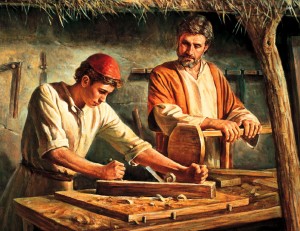No Account in Nazareth
The earliest known gospel, Mark, has no tale to tell of Jesus before his baptism as an adult. There is nothing about a miraculous conception or birth, no angelic annunciation, no child prodigy stories such as we find in the other New Testament gospels. Considered as a historical figure (which despite all the mythology attaching to him, Jesus may have been), these is nothing at all odd that his early, private years should have nothing remarkable about them. But the more of a glorified mythic hero Jesus became in Christian imagination, his early life became a puzzle: if Jesus was from the very beginning a god on earth, what sort of childhood adventures must he have had? Surely the Son of the living God cannot have been merely cooling his heels in Nazareth all that time? The logic is precisely the same as that of Superman, Clark Kent, and Superboy.
By Dr. Robert Price
I am, as it happens, both a New Testament scholar and a huge comic book fan. Since comic books are the modern American myths, it is not surprising to find parallels between them and ancient myths. And these parallels can be quite helpful for understanding both literatures. In the present case, think of the first version of Superman. He came on the public scene as a superhero for the first time as an adult, in Action Comics, 1938, having whiled away his early years in Smallville. He took the alias Clark Kent and worked for the Daily Star (later the Daily Planet), then appeared publicly as Superman. His adventures proved so popular that he got a second title each month, Superman. But fans wanted even more, so a new title was added to answer the question many readers were asking: how can Kent keep the secret of his powers all those hours of every day at his desk, taking guff from Perry White and Lois Lane? Worse yet, how could he possibly have passed through childhood and adolescence without blabbing the secret of his super-abilities? The answer: he didn’t. Already in Smallville, according to the new, revisionist account, mild-mannered Clark Kent had countless adventures as Superboy. Eventually, the editors decided to push the whole thing back further, and we began reading the adventures of Superbaby!
The same sequence occurs in the Jesus legend. From a half-historical story of Jesus as a teacher, healer, and exorcist, the early Christian imagination pushed back Jesus’ divine sonship to his childhood and birth and began filling in the gaps with new stories.(For that matter, as Wilhelm Wrede, Raymond E. Brown, John A.T. Robinson and others showed, the divine sonship was first attached to the second coming, then to the resurrection, then to the baptism, then to the miraculous birth, and, in John’s gospel, back before creation itself!). They were attempts to answer the question: what was Jesus doing during those “missing” years? And they were filled in, not from any historical memory, but rather from creative inference: what must young Jesus have been doing?
The Baby and the Bathwater
The tales collected into texts like the Infancy Gospel of Matthew, the Gospel of Thomas the Israelite, the Arabic Gospel of the Infancy, and the Proto-Gospel of James (variously dating from the second century CE on through Late Antiquity) are one and all theological foreshadowings. They are every one of them inferences backward from prior beliefs about the adult Jesus Christ. A number of them have to do with boy Jesus running afoul of scribes and Pharisees, as he does as an adult in the canonical gospels. In one episode, Joseph takes Jesus to a village scribe, who proposes to teach the lad Torah, starting with the alphabet. Jesus contemptuously tells off the teacher: not only does Jesus know the alphabet, but he also knows the kabbalistic significance of each letter, as the teacher himself does not! For such smart-mouthing, the scribe raps Jesus’ knuckles with a ruler – and keels over dead!
In another tale, familiar to the writer(s) of the Koran (sura 5:110-111), young Jesus is modeling clay birds by the stream. Young Pharisees carp that he is violating the Sabbath with such “work,” whereupon Jesus claps his hands, bringing the birds to life. Such stories mean to tell us that Jesus’ friction with the Jewish authorities goes back to the beginning. It was in the blood and could not have been different.
The young Jesus, a divinity after all, is impatient with foolish mortals. Once a neighborhood kid runs past him and punches him in the arm, whereupon Jesus tells him, “You will go no farther on your way!” And the kid drops dead! Joseph is perturbed and tweaks his son’s ear, but he has overstepped his bounds, and Jesus tells him, “It is enough that you should see me, but not touch me! If you knew who I am, you would not grieve me! I am with you now, but I was made before you.” But sometimes dad and son got along better. Once Joseph, a carpenter, commissioned to make a bed, has cut one of the beams too short. As he bemoans his error, young Jesus suggests they each take one end of the beam and pull: it stretches to the right length, and Joseph thanks God for such a boy!
The lad Jesus performs various healings. Even his bathwater can heal when taken away and poured on the afflicted. The point? “Jesus Christ: the same yesterday, today, and forever” (Hebrews 13:8). This point becomes even more obvious in one Infancy Gospel story in which Judas Iscariot’s mother, hearing of the bathwater cures, brings the infant Iscariot to Jesus for exorcism: already the little creep is showing his true colors by biting everybody he comes near! Sure enough, little Judas tries to take a chunk out of Jesus, but is prevented. Nonetheless, he does manage to hit Jesus a childish blow on the ribcage before the demon leaves him, and guess what? It turns out to be this exact spot where the spear of the Roman guard will pierce his side thirty years hence!
Written Before the Foundation of the World
All these episodes function the same way prophecies of Jesus did in the early Christian imagination. They believed Jesus’ saving deeds had already been predicted by Isaiah, Jeremiah, Hosea, Zechariah, etc. In fact, the gospel incidents can be shown to be later rewrites of those very same Old Testament passages: no wonder they correspond! The direction of motion is from Jesus backward, not from the Prophets forward to Jesus. And even so, originally there were no miracle stories in the early life of Jesus. They were posited later as (fictive) anticipations of what the canonical gospels have him doing during his public ministry.
This means the whole gospel story is settled before it happens. Once it does happen, it will be but a kind of charade, no surprises. The gospels themselves partake of this kind of narrative structure, which Tzvetan Todorov calls “ritual narrative,” where the point is not to entertain the reader by unfolding some plot or mystery initially unknown. Rather the function of such a narrative, revealing its roots in cultic ritual rehearsal (Von Rad’s “Theology of Recital”) is to rehearse again and again the theological belief underlying the story from start to finish. Monika Hellwig points out the similarity of the baptism and transfiguration stories in the gospels, in which a heavenly voice proclaims Jesus as God’s son (echoed by the human voices of John the Baptist, Simon Peter, Mary of Bethany, and others). She calls such similar scenes “icons” parallel to one another, different depictions of the same theological point, not different points in historical time. The idea is to celebrate and confess again and again the Christian creed for the sake of which the story is being told. This is why there is no real suspense in the gospels. The evangelists kill any suspense again and again, on purpose, by telling you from the start that Jesus is going to be betrayed, killed, raised from the dead. Again, no surprises here!
Precisely this mode of thought has produced the Infancy Gospels and their amusing tales. Their authors mean to present a psychologically grotesque and incredible hero: a Jesus who is God in diapers, never having to learn anything, barely able to contain his irritation with foolish adult mortals. Theirs is a Jesus who cannot have grown emotionally or intellectually: such is the fodder of human biography, not of the tidings of the incarnate Son of God. Protestant theologian Martin Kähler saw this flaw in the “historical Jesus” quest of the nineteenth century. Those scholars sought to distill from the legend-laden gospels of Matthew, Mark, Luke, and John a human Jesus whose personal and spiritual growth might stand as a model for our own and thus revitalize modern Christianity. Such was the credo of Liberal Protestantism. But Kähler objected that such a construct of modern psychologism would never produce a Jesus Christ worthy of Christian faith. He would stand on our side of the curtain, not on God’s, and traditional Christianity would be gone. The ancient and unsophisticated tale-spinners of the Infancy Gospels knew the same thing, so they by no means sought to provide a socio-psycho-biography of their Savior. Thus the result is more like the legends of Krishna than the life of Gandhi.
Missing Tales of Missing Years
Why did these ancient documents drop from sight to such an extent that many modern readers have never heard of them? The real question is, why were they excluded from the canon of the New Testament? My guess is that they were suspected of teaching the heresy of “docetism,” the belief that Jesus Christ was not truly human, but only “appeared” (Greek: dokeo) to be so, like a myth of Zeus coming down to earth in human form, or an angel. Widespread among many Christians, this theology seemed to undermine the doctrine of the physical death of Jesus on the cross and thus the reality of his saving sacrifice. So it was condemned. Docetism took the Infancy Gospels with it, because anyone can see that the young Jesus they portray is no real human being at all! He knows everything and needs to learn nothing. He is a god trapped in a boy’s body.
But didn’t I just argue that this depiction of Jesus was consistent with Christian belief in his true divinity, no mere human “religious founder”? Well, yes. But the process of hammering out the dogma of Jesus Christ was a series of pendulum swings between Christologies (theologies of Christ) highlighting his divinity and those accentuating his humanity. The theologians wanted to come down right in the middle, with a Jesus who had been true God and true man, one person with both these natures. But depending where you stood, the middle point looked quit different. It’s all in the eye of the believer. And while the tales of the boy God were clearly set against a merely human Jesus, the tables turned easily to show that what they depicted was a merely divine Jesus, and that proved to be equally heretical!



